Fieldtrips and Virtual Tours as Geotourism Resources: Examples from the Sesia Val Grande UNESCO Global Geopark (NW Italy)
Abstract
1. Introduction
- “landscape, interaction and time”: the geodiversity deeply contributes not only to the structure of a geographical area, but also to its cultural meaning and to its perception by people, either within natural or urban areas [12,13]. As a result, the landscape character derives from the action and interaction of natural and/or human factors (European Landscape Convention of Firenze; [14]) and their historical changes [15];
- “territorial dimensions of geodiversity and geoheritage”: within a territory, legal and economic issues related to the protection, preservation, and exploitation of geoheritage also have to be considered [8,16]. A comprehensive, integrated approach to the management of any natural heritage should be addressed, for combining directions from international, national, and regional laws and for stimulating a balance between the need to protect and enhance the natural heritage and the legitimate needs of local populations or visitors [17].
2. Study Area
2.1. Location
2.2. The Sesia-Val Grande UNESCO Geopark History
- -
- The ERASMUS+ Project “GEOclimHOME: Geoheritage and climate change discovering the secrets of home” (https://geoclimhomeblog.wordpress.com/). This is a three-year project funded in 2015 by the Erasmus+ Programme within the Key Action 2 (cooperation for innovation and the exchange of good practices which promote strategic partnership for school education). It supports high school teaching and scientific research between Rokua (Finland) and Sesia-Val Grande (Italy) UNESCO Geoparks. It aims to improve both the general perception of climate and environmental changes in Europe and the appraisal of geoheritage. The project was implemented with the participation of the Chablais UNESCO Geopark (France).
- -
- The PROGEO-Piemonte Project (http://www.progeopiemonte.it/). This offers an innovative approach for the management and enhancement of the geological heritage of the Piemonte Region. Within the project, nine “geothematic areas” have been identified for representing the regional geodiversity of the Piemonte Region. Geological sites identification, the enhancement of museum collections, the activation of educational projects with the schools, the installation of exhibitions, and nature trails designed to promote the geotourism, by means of virtual tours and fieldtrips, are among its main aims. Its main actions concern: (i) the progress of scientific knowledge; (ii) land development, education, and communication through innovative methodologies; (iii) collaboration with the local communities in order to involve them and provide them with benefits.
- -
- SITINET – Geological and archeological sites of the Insubria Region. This was a project devoted to the inventory of the geological and archeological spots in the Insubria region, including the Ossola area (http://www.sitinet.org/). It ended in 2013, just during the acceptance of the study area in the EGN, which was also a starting point for the inventory of the geoheritage of the geopark.
2.3. Geology
2.3.1. The Canavese Line
- i.
- The northern border of the Ivrea-Verbano Zone (South Alpine basement), with its Permo-Mesozoic cover;
- ii.
- The Canavese zone (South Alpine domain; [49]), consisting of amphibolite facies basement rocks overlain by Permian silicoclastic sediments and Triassic-Liassic carbonate rocks (sedimentary and metamorphic); the latter were accreted to the Ivrea-Verbano Zone margin, before the Alpine metamorphic greenschists facies overprint and are regarded as the distal continental margin of the Adria plate facing the Ligurian–Piedmont Ocean [49];
- iii.
- The southern border of the Sesia-Lanzo Zone (Austroalpine domain) [44], well exposed in the Ossola Valley.
2.3.2. The South Alpine Domain
- i.
- The Kinzigite Formation: a metamorphosed volcano-sedimentary sequence, composed of dominant metapelites, with minor quartzites, thin meta-carbonate horizons and interlayered metabasites [57]. Mantle peridotite lenses are tectonically interfingered with the metasedimentary rocks [58], especially in the north-western part, near the CL (Balmuccia in the Sesia Valley, Premosello in the Ossola Valley and Finero in the Cannobina Valley: [59] and references therein). The metamorphic grade decreases from the granulite facies in the northwest to the upper amphibolite facies in the southeast [60].
- ii.
- The Mafic Complex: gabbroic to dioritic intrusive rocks, representing the deepest level of the Sesia Magmatic System (described below).
- i.
- Strona-Ceneri Zone: this consists of two types of paragneisses. The Gneiss Minuti, fine-grained metasandstones still preserving relicts of sedimentary structures, and the Cenerigneiss, coarse-grained to conglomeratic gneisses containing a variety of enclaves (quartzite pebbles, nodules rich in aluminium silicates, fragments of metamorphic rocks). Both gneisses contain calc-silicate enclaves, deriving from calcareous concretions frequent in arenaceous deposits. Gneiss Minuti and Cenerigneiss are respectively interpreted as well sorted deposits from turbidity currents and as mass flow turbidites, deposited in an accretionary prism along an active continental margin [62,63].
- ii.
- Strona-Ceneri Border Zone [64]: a continuous horizon, one to several hundreds of meters thick, between the Strona-Ceneri Zone and the Scisti dei Laghi. It mainly consists of banded amphibolites, with lenses of ultramafites, metagabbros, garnet bearing amphibolites (retrogressed eclogites) and minor paragneisses. The banded amphibolites are an example of the Leptynite-Amphibolite Group (LAG), an association widespread throughout the Hercynian belt in Europe. The LAG is formed by tuffites of alternate mafic and acidic composition deposited in a marine environment [65].
- iii.
- Scisti dei Laghi: mainly garnet and staurolite and kyanite micaschists, with minor paragneiss intercalations.
2.3.3. The Sesia Magmatic System
- i.
- The Mafic Complex (part of the Ivrea-Verbano Zone): this is an 8-km-thick composite layered intrusion (peridotites, pyroxenites, norites, and the main gabbro [72,73,74]), which intruded the deep crust around 288 Ma ago [75]. Along the intrusive contacts, partial melting of the kinzigites produced migmatites within 1 to 2 km from the intrusion [76]. Residual melt from the Mafic Complex and silicic melt generated by anatexis migrated to higher crustal levels.
- ii.
- The Valle Mosso granite: this is a compositionally zoned pluton [77] grading upwards into a fine-grained to granophyric facies with miarolitic cavities. It also contains some basaltic to andesitic dykes and intrudes the base of the overlying caldera.
- ii.
- The Sesia Supervolcano: this forms the upper part of the system, together with relicts of a bimodal volcanic field of basaltic andesite and rhyolite. The supervolcano, partially covered by younger sedimentary deposits, is a huge rhyolitic caldera with a diameter exceeding 15 km and an estimated volume of ignimbrite erupted above 300 km3 [78]. The caldera-forming events are well documented along the Sesia Valley and its hydrographic network, with beautiful exposures of volcanic megabreccia within the welded rhyolitic ignimbrite that fills the caldera, and huge blocks of country rocks (Scisti dei Laghi) slided into the caldera during the eruption. After Quick et al. [78], volcanism lasted approximately 6 My, beginning about 288 Ma and culminating in the caldera-forming eruption at about 282 Ma. The karstic Triassic marine carbonate of Monte Fenera is deposited on the caldera ignimbrite.
2.4. Geomorphology
2.4.1. Lithostructural Constrains and Long-term Geomorphological History
2.4.2. “Recent” and Present-day Geomorphological Landforms and Processes
2.5. Georesources and Ancient Human Settlements
- -
- -
- Carbonate metasedimentary rocks, dated back to Permian-Mesozoic, and marbles. The metacarbonates have a stripe-like distribution along the Canavese Line, within the Ivrea-Verbano and Canavese Zones. Especially in the Ossola Valley, they were used for lime production within the lime kilns (e.g., the Loana Valley [99]; SF 4-I). Marbles occurring as lenses within the Ivrea-Verbano kinzigites were extensively quarried as ornamental rocks since ancient times: the most famous quarry is the Cava Madre in Candoglia, exclusively reserved since 1387 AD for the Milan Cathedral (Duomo di Milano) (Figure 5b) [100].
- -
3. Materials and Methods
3.1. Geoheritage Analysis
- (i)
- A primary and a secondary scientific interest, according to the topics characterizing each one of them: GM = geomorphology; GRS = georesources; HYD = hydrogeology; M = mineralogy; P = petrography; PAL = paleontology; SD = sedimentology; SS = soil science; ST = structural. Moreover, the primary interest was classified according to its level of importance at the international, national, regional or local scale (sensu Panizza [104]).
- (ii)
3.2. Methods for Implementing Geotrails
3.2.1. MobileApp and Websites Tools for Enhancement of Virtual Tours within Geosites
3.2.2. Multidisciplinary Educational Fieldworks for Understanding Spatio-Temporal Evolution of the Alpine Landscape
4. Results
4.1. Geosite Inventory
4.2. Geotrails Analysis
4.2.1. “Viaggio Spazio-Temporale Nelle Profondità Della Terra” (A Space-Time Journey Inside the Earth depths; 18, SF 2)
- i.
- The boundary between the Central and the Southern Alps (c, SF 4-II) is along the Insubric Line. The attention is focused on the juxtaposition between the Central Alps, consisting of refolded basement nappes affected by the Alpine metamorphism, and the Southern Alps, which are little affected by that phase and preserving much older structures. The visitors may observe the phyllonites (8, SF 1; b, SF 4-II), produced by the deformation of Austroalpine rocks along the fault zone, and their contact with the mafic granulites of the Ivrea-Verbano Zone (Southern Alps).
- ii.
- A journey from the upper to the lower crust: Along the path, the visitor ideally walks deeper and deeper inside the crust, reaching rocks formed at a depth of over 30 km.
- iii.
4.2.2. “Il Supervulcano della Valsesia” (The Sesia Supervolcano; 2, SF 2)
4.2.3. L’ Anello Geoturistico della Valle Loana (The Loana Valley Geotouristic Ring; 1, SF 2)
- i.
- Lithological and structural control on geomorphological modelling—the Loana Valley is a S-N oriented valley that was carved by glaciers during the Pleistocene. The head of the valley is characterized by a glacio-structural saddle due to the presence of the Canavese Line (a, SF 4-I). The area represents a noteworthy place for the study of deformations related to the CL (i.e., Scaredi Formation; [41]), as testified by several authors [44,50,51,52]. The influence of the deformation pattern on the surficial modelling is particularly evident where different lithotypes, including marbles (27, SF 1), which crop out in structural contact, producing different relief features.
- ii.
- Ecologic support role on landforms—the geomorphic processes interesting currently and during the past the Loana valley deeply affect the vegetation distribution in the area. Bollati et al. [99,113] detected specific patterns of disturbance on vegetation growing on the geosites located along the valley bottom (18, SF 1; b, c, SF 4-I), and on vegetation growing on carbonate isolated reliefs modelled by glaciers in the past, near the head of the valley (17, SF 1; Figure 12b). These results were proposed in form of simple exercises, addressed to general public and schools, allowing them to relate the vegetation behavior with the geomorphological activity (Figure 9c).
- iii.
- Cultural value of georesources—in addition to the most famous "Pietra ollare” (x, SF 1), along this trail, the attention is focused on carbonate outcrops located in the valley and quarried in the past to produce lime (Figure 9a). Old lime kilns, located in the valley bottom, have been recently restored with the possibility, for tourists and schools, of experimenting lime production (Figure 9b; d, SF 4-I). The carbonate outcrops (17, SF 1) represent georesources, a particularly relevant consideration in a geopark where the link with local populations and resources usages is extremely important.
4.2.4. L’Itinerario Glaciologico del Parco Naturale Alta Valsesia (Upper Sesia Valley Natural Park Glaciological trail, 4, SF 2)
- i.
- The process of glacial erosion and related landforms, from the micro to the macro scale—at the beginning of the trail, it is possible to observe the “Caldaie del Sesia” landform system (e, SF 4-V) modelled by subglacial water of the ancient Sesia Glacier. The system is composed by a gorge where the Sesia River is channeled through a rock step, producing a high waterfall, and a huge kettle. Another example is a roche moutonnée with potholes, good example of landforms related to abrasion and/or plucking processes. Finally, some geostops illustrate large scale erosion processes, particularly those related to the Bors Valley hanging valley and glacial cirque.
- ii.
- The processes and landforms related to glacial accumulation—hikers walk along the ridge of a glacial deposit, the “Fondecco moraine” (d, SF 4-V). This shows the dimensions reached by the ancient Sesia Glacier during the late glacial advances, during the end of Pleistocene.
- iii.
- Glaciers and their dynamics—glaciers of the Sesia Valley side of the Monte Rosa (31, SF 1; Figure 12f; g, h, SF 4-V) are described with information on their past areal dimensions. The trail ends in proximity of the current glacier snout, where it is possible to observe crevasses and seracs; moreover, it is also possible to observe moraines and roche mountonnée (f, SF 4-V) shaped by glaciers during the Little Ice Age.
4.2.5. Geological-Pedological Trail of the Cimalegna Plateau (Itinerario geologico-pedologico dell’altopiano di Cimalegna; 3, SF 2)
4.2.6. Monte Fenera Caves Trail (Sentiero delle Grotte del Monte Fenera; 10, SF 2)
4.2.7. Sentiero Azzurro (The Azzurro Trail; 9, SF 2)
4.3. The Off-Site Geoheritage within the Sesia-Val Grande UNESCO Global Geopark (Museum, Geo-Laboratories)
5. Discussions and Conclusions
Supplementary Materials
Author Contributions
Funding
Acknowledgments
Conflicts of Interest
References
- Dowling, R.K.; Newsome, D. Handbook of Geotourism; Edward Elgar Publishing: Cheltenham, UK, 2018; Volume 520. [Google Scholar]
- O’Halloran, D.; Green, C.; Harley, M.; Knill, J. (Eds.) Geological and landscape conservation. In Proceedings of the Malvern International Conference 1993; The Geological Society, Geological Society Publishing House: London, UK, 1994; Volume 530. [Google Scholar]
- Prosser, C.; Murphy, M.; Larwood, J. Geological Conservation: A Guide to Good Practice; English Nature: Peterborough, UK, 2006; Volume 145.
- Reynard, E.; Brilha, J. Geoheritage: Assessment, Protection, and Management; Elsevier: Amsterdam, The Netherlands, 2017; Volume 482. [Google Scholar]
- Sallam, E.S.; Abd El-Aal, A.K.; Fedorov, Y.A.; Bobrysheva, O.R.; Ruban, D.A. Geological heritage as a new kind of natural resource in the Siwa Oasis, Egypt: The first assessment, comparison to the Russian South, and sustainable development issues. J. Afr. Earth Sci. 2018, 144, 151–160. [Google Scholar] [CrossRef]
- Dowling, R.K. Geotourism’s global growth. Geoheritage 2011, 3, 1–13. [Google Scholar] [CrossRef]
- Hose, T.A. 3G’s for modern geotourism. Geoheritage 2012, 4, 7–24. [Google Scholar] [CrossRef]
- Gray, J.M. Geodiversity: Valuing and Conserving Abiotic Nature, 2nd ed.; Wiley Blackwell: Chichester, West Sussex, UK, 2013; Volume 508. [Google Scholar]
- Knudsen, D.C.; Metro-Roland, M.M.; Soper, A.K.; Greer, C.E. Landscape, Tourism, and Meaning; Ashgate Publishing: Burlington, VT, USA, 2008; Volume 176. [Google Scholar]
- Bollati, I.; Coratza, P.; Panizza, V.; Pelfini, M. Lithological and structural control on Italian mountain geoheritage: Opportunities for tourism, outdoor and educational activities. Quaest. Geog. 2018, 37, 53–73. [Google Scholar] [CrossRef]
- Kubalíková, L. Assessing geotourism resources on a local level: A case study from Southern Moravia (Czech Republic). Resources 2019, 8, 150. [Google Scholar] [CrossRef]
- Borghi, A.; d’Atri, A.; Martire, L.; Castelli, D.; Costa, E.; Dino, G.; Favero Longo, S.E.; Ferrando, S.; Gallo, L.M.; Giardino, M.; et al. Fragments of the Western Alpine Chain as historic ornamental stones in Turin (Italy): Enhancement of urban geological heritage through geotourism. Geoheritage 2014, 6, 41–55. [Google Scholar] [CrossRef]
- Pelfini, M.; Brandolini, F.; D’Archi, S.; Pellegrini, L.; Bollati, I. Papia civitas gloriosa: Urban geomorphology for a thematic itinerary on geocultural heritage in Pavia (Central Po Plain, N Italy). J. Maps 2020, 1–9. [Google Scholar] [CrossRef]
- Council of Europe. Explanatory Report to the European Landscape Convention. Available online: http://conventions.coe.int/Treaty/en/Reports/Html/176.htm (accessed on 18 April 2020).
- Giardino, M.; Mortara, G.; Borgatti, L.; Nesci, O.; Guerra, C.; Lucchetti, C.C. Dynamic geomorphology and historical iconography. Contributions to the knowledge of environmental changes and slope instabilities in the Apennines and the Alps. In Engineering Geology for Society and Territory; Lollino, G., Giordan, D., Marunteanu, C., Christaras, B., Yoshinori, I., Margottini, C., Eds.; Springer: Berlin, Germany, 2015; Volume 8, pp. 463–468. [Google Scholar] [CrossRef]
- Dauvin, J.C.; Lozachmeur, O.; Capet, Y.; Dubrulle, J.B.; Ghezali, M.; Mesnard, A.H. Legal tools for preserving France’s natural heritage through integrated coastal zone management. Ocean. Coast. Manag. 2004, 47, 463–477. [Google Scholar] [CrossRef]
- Lucchesi, S.; Giardino, M. The role of geoscientists in human progress. Ann. Geophys. 2012, 55, 355–359. [Google Scholar] [CrossRef]
- Perotti, L.; Carraro, G.; Giardino, M.; De Luca, D.A.; Lasagna, M. Geodiversity evaluation and water resources in the Sesia Val Grande UNESCO Geopark (Italy). Water 2019, 11, 2102. [Google Scholar] [CrossRef]
- Wimbledon, W.A.P.; Benton, M.J.; Bevins, R.E.; Black, G.P.; Bridgland, D.R.; Cleal, C.J.; Cooper, R.G.; May, V.J. The development of a methodology for the selection of British geological sites for conservation: Part 1. Mod. Geol. 1995, 20, 159–202. [Google Scholar]
- Wimbledon, W.A.P. GEOSITES-a new conservation initiative. Episodes 1996, 19, 87–88. [Google Scholar] [CrossRef]
- Bollati, I.; Crosa Lenz, B.; Zanoletti, E.; Pelfini, M. Geomorphological mapping for the valorization of the alpine environment. A methodological proposal tested in the Loana Valley (Sesia Val Grande Geopark, Western Italian Alps). J. Mt. Sci. 2017, 14, 1023–1038. [Google Scholar] [CrossRef]
- Brilha, J. Inventory and quantitative assessment of geosites and geodiversity sites: A review. Geoheritage 2016, 8, 119–134. [Google Scholar] [CrossRef]
- Ferrero, E.; Giardino, M.; Lozar, F.; Giordano, E.; Belluso, E.; Perotti, L. Geodiversity action plans for the enhancement of geoheritage in the Piemonte region (north-western Italy). Ann. Geophys. 2012, 55, 487–495. [Google Scholar] [CrossRef]
- Orion, N. A Model for the development and implementation of field trips as an integral part of the Science curriculum. Sch. Sci. Math. 1993, 93, 325–331. [Google Scholar] [CrossRef]
- Garavaglia, V.; Pelfini, M. Glacial geomorphosites and related landforms: A proposal for a dendrogeomorphological approach and educational trails. Geoheritage 2011, 3, 15–25. [Google Scholar] [CrossRef]
- Magagna, A.; Ferrero, E.; Giardino, M.; Lozar, F.; Perotti, L. A selection of geological tours for promoting the Italian geological heritage in the secondary schools. Geoheritage 2013, 5, 265–273. [Google Scholar] [CrossRef]
- Bollati, I.M.; Crosa Lenz, B.; Zanoletti, E. A procedure to structure multidisciplinary educational fieldworks for understanding spatio-temporal evolution of the Alpine landscape. Rend. Online Soc. Geol. Ital. 2019, 49, 11–19. [Google Scholar] [CrossRef]
- Giardino, M.; Lombardo, V.; Lozar, F.; Magagna, A.; Perotti, L. GeoMedia-web: Multimedia and networks for dissemination of knowledge on geoheritage and natural risk. In Engineering Geology for Society and Territory; Lollino, G., Arattano, M., Giardino, M., Oliveira, R., Peppoloni, S., Eds.; Springer: Berlin, Germany, 2014; Volume 7, pp. 147–150. [Google Scholar] [CrossRef]
- Bertotto, S.; Perotti, L.; Bacenetti, M.; Damiano, E.; Marta, C.; Giardino, M. Integrated geomatic techniques for assessing morphodynamic processes and related hazards in glacial and periglacial areas (Western Italian Alps) in a context of climate change. In Engineering Geology for Society and Territory; Lollino, G., Manconi, A., Clague, J., Shan, W., Chiarle, M., Eds.; Springer: Berlin, Germany, 2015; Volume 1, pp. 173–176. [Google Scholar] [CrossRef]
- Coratza, P.; De Waele, J. Geomorphosites and natural hazards: Teaching the importance of Geomorphology in society. Geoheritage 2012, 4, 195–203. [Google Scholar] [CrossRef]
- Ghiraldi, L.; Giordano, E.; Perotti, L.; Giardino, M. Digital tools for collection, promotion and visualisation of geoscientific data: Case study of Seguret Valley (Piemonte, NW Italy). Geoheritage 2014, 6, 103–112. [Google Scholar] [CrossRef]
- Santos, I.; Henriques, R.; Mariano, G.; Pereira, D.I. Methodologies to represent and promote the geoheritage using Unmanned Aerial Vehicles, multimedia technologies, and augmented reality. Geoheritage 2018, 10, 143–155. [Google Scholar] [CrossRef]
- Magagna, A.; Palomba, M.; Bovio, A.; Ferrero, E.; Gianotti, F.; Giardino, M.; Judica, L.; Perotti, L.; Tonon, M.D. GeoDidaLab: A laboratory for environmental education and research within the Ivrea Morainic Amphitheatre (Turin, NW Italy). Rend. Online Soc. Geol. Ital. 2018, 45, 68–76. [Google Scholar] [CrossRef]
- Tormey, D. New approaches to communication and education through geoheritage. Int. J. Geoheritage Parks 2019, 7, 192–198. [Google Scholar] [CrossRef]
- Cayla, N.; Hobléa, F.; Reynard, E. New digital technologies applied to the management of geoheritage. Geoheritage 2014, 6, 89–90. [Google Scholar] [CrossRef]
- Giordano, E.; Magagna, A.; Ghiraldi, L.; Bertok, C.; Lozar, F.; d’Atri, A.; Dela Pierre, F.; Giardino, M.; Natalicchio, M.; Martire, L.; et al. Multimedia and virtual reality for imaging the climate and environment changes through Earth history: Examples from the Piemonte (NW Italy) geoheritage (PROGEO-Piemonte Project). In Engineering Geology for Society and Territory; Lollino, G., Giordan, D., Marunteanu, C., Christaras, B., Yoshinori, I., Margottini, C., Eds.; Springer: Berlin/Heidelberg, Germany, 2015; Volume 8, pp. 257–260. [Google Scholar] [CrossRef]
- Lozar, F.; Clari, P.; Dela Pierre, F.; Natalicchio, M.; Bernardi, E.; Violanti, D.; Costa, E.; Giardino, M. Virtual tour of past environmental and climate change: The Messinian Succession of the Tertiary Piedmont Basin (Italy). Geoheritage 2015, 7, 47–56. [Google Scholar] [CrossRef]
- Bacenetti, M.; Bertotto, S.; Ghiraldi, L.; Giardino, M.; Magagna, A.; Palomba, M.; Perotti, L. Geomathics tools and web-based open-source GIScience public participation field approach for field data collection: Supports for a Civil Protection exercise in a hydrological risk scenario. In Engineering Geology for Society and Territory; Lollino, G., Arattano, M., Giardino, M., Oliveira, R., Peppoloni, S., Eds.; Springer: Berlin, Germany, 2014; Volume 7, pp. 181–184. [Google Scholar] [CrossRef]
- Perotti, L.; Palomba, M.; D’Atri, A.; Lozar, F.; Giardino, M. Tutti I Colori Di Una Regione—Tredici Itinerari Geologici in Piemonte; Museo di Scienze Naturali: Torino, Italy, 2019; Volume 372. [Google Scholar]
- Gambino, F.; Borghi, A.; d’Atri, A.; Gallo, L.M.; Ghiraldi, L.; Giardino, M.; Martire, L.; Palomba, M.; Perotti, L.; Macadam, J. TOURinSTONES: A free mobile application for promoting geological heritage in the city of Torino (NW Italy). Geoheritage 2019, 11, 3–17. [Google Scholar] [CrossRef]
- Steck, A.; Della Torre, F.; Keller, F.; Pfeifer, H.-R.; Hunziker, J.; Masson, H. Tectonics of the Lepontine Alps: Ductile thrusting and folding in the deepest tectonic levels of the Central Alps. Swiss J. Geosci. 2013, 106, 427–450. [Google Scholar] [CrossRef]
- Giardino, M.; Mortara, G.; Chiarle, M. The glaciers of the Valle d’Aosta and Piemonte regions: Records of present and past environmental and climate changes. In Landscapes and Landforms of Italy. World Geomorphological Landscapes; Soldati, M., Marchetti, M., Eds.; Springer: Berlin, Germany, 2017; pp. 77–88. [Google Scholar] [CrossRef]
- Laubscher, H.P. Large-scale, thin-skinned thrusting in the Southern Alps: Kinematic models. Geol. Soc. Am. Bull. 1985, 96, 710–718. [Google Scholar] [CrossRef]
- Schmid, S.M.; Zingg, A.; Handy, M. The kinematics of movements along the Insubric Line and the emplacement of the Ivrea Zone. Tectonophysics 1987, 135, 47–66. [Google Scholar] [CrossRef]
- Steck, A. Tectonics of the Simplon massif and Lepontine gneiss dome: Deformation structures due to collision between the underthrusting European plate and the Adriatic indenter. Swiss J. Geosci. 2008, 101, 515–546. [Google Scholar] [CrossRef]
- Manzotti, P.; Ballèvre, M.; Zucali, M.; Robyr, M.; Engi, M. The tectonometamorphic evolution of the Sesia–Dent Blanche nappes (internal Western Alps): Review and synthesis. Swiss J. Geosci. 2014, 107, 309–336. [Google Scholar] [CrossRef]
- Festa, A.; Balestro, G.; Borghi, A.; De Caroli, S.; Succo, A. The role of structural inheritance in continental break-up and exhumation of Alpine Tethyan mantle (Canavese Zone, Western Alps). Geosci. Front. 2020, 11, 167–188. [Google Scholar] [CrossRef]
- Zanoni, D.; Bado, L.; Spalla, M.I.; Zucali, M.; Gosso, G. Evoluzione strutturale e metamorfica pre-sin-e post-intrusiva nell’incassante dei plutoni oligocenici di Biella e Traversella. Rend. Online Soc. Geol. Ital. 2006, 2, 196–198. [Google Scholar]
- Ferrando, S.; Bernoulli, D.; Compagnoni, R. The Canavese zone (internal Western Alps): A distal margin of Adria. Schweiz. Mineral. Petrogr. Mitt. 2004, 84, 237–256. [Google Scholar]
- Reinhardt, B. Geologie und Petrographie der Monte Rosa-Zone der Sesia-Zone und des Canavese im gebiet zwischen Valle d’Ossola und Valle Loana (Prov. di Novara, Italien). Schweiz. Mineral. Petrogr. Mitt. 1966, 46, 533–678. [Google Scholar]
- Kruhl, J.H.; Voll, G. Fabrics and metamorphism from the Monte Rosa Root Zone into the Ivrea Zone near Finero, southern margin of the Alps. Schweiz. Mineral. Petrogr. Mitt. 1976, 56, 627–633. [Google Scholar]
- Altenberger, U.; Hamm, N.; Kruhl, J.H. Movements and metamorphism North of the Insubric Line between Val Loana and Val d’Ossola (Italy). Jb. Geol. B.-A. 1987, 130, 365–374. Available online: https://www.zobodat.at/pdf/JbGeolReichsanst_130_0365.pdf (accessed on 28 April 2020).
- Boriani, A.; Burlini, L.; Sacchi, R. The Cossato-Mergozzo-Brissago Line and the Pogallo Line (Southern Alps, Northern Italy) and their relationships with the late-Hercynian magmatic and metamorphic events. Tectonophysics 1990, 182, 91–102. [Google Scholar] [CrossRef]
- oriani, A.; Giobbi Origoni, E.; Borghi, A.; Caironi, V. The evolution of the “Serie dei Laghi” (Strona-Ceneri and Scisti dei Laghi): The upper component of the Ivrea-Verbano crustal section; Southern Alps, North Italy and Ticino, Switzerland. Tectonophysics 1990, 182, 103–118. [Google Scholar] [CrossRef]
- Rutter, E.H.; Brodie, K.H.; Evans, P.J. Structural geometry, lower crustal magmatic underplating and lithospheric stretching in the Ivrea-Verbano zone, northern Italy. J. Struct. Geol. 1993, 15, 647–662. [Google Scholar] [CrossRef]
- Quick, J.E.; Sinigoi, S.; Mayer, A. Emplacement dynamics of a large mafic intrusion in the lower crust, Ivrea-Verbano Zone, northern Italy. J. Geophys. Res. 1994, 99, 21559–21573. [Google Scholar] [CrossRef]
- Sills, J.D.; Tarney, J. Petrogenesis and tectonic significance of amphibolites interlayered with metasedimentary gneisses in the Ivrea Zone, Southern Alps, northwest Italy. Tectonophysics 1984, 107, 187–206. [Google Scholar] [CrossRef]
- Quick, J.E.; Sinigoi, S.; Mayer, A. Emplacement of mantle peridotite in the lower continental crust, Ivrea-Verbano zone, northwest Italy. Geology 1995, 23, 739–742. [Google Scholar] [CrossRef]
- Zanetti, A.; Mazzucchelli, M.; Sinigoi, S.; Giovanardi, T.; Peressini, G.; Fanning, M. SHRIMP U–Pb zircon triassic intrusion age of the Finero Mafic Complex (Ivrea–Verbano Zone, Western Alps) and its geodynamic implications. J. Petrol. 2013, 54, 2235–2265. [Google Scholar] [CrossRef]
- Zingg, A.; Handy, M.R.; Hunziker, J.C.; Schmid, S.M. Tectonometamorphic history of the Ivrea Zone and its relationship to the crustal evolution of the Southern Alps. Tectonophysics 1990, 182, 169–192. [Google Scholar] [CrossRef]
- Pistone, M.; Müntener, O.; Ziberna, L.; Hetényi, G.; Zanetti, A. Report on the ICDP workshop DIVE (Drilling the Ivrea–Verbano zonE). Sci. Dril. 2017, 23, 47–56. [Google Scholar] [CrossRef]
- Boriani, A.; Caironi, V.; Colombo, A.; Giobbi Origoni, E. The Cenerigneiss: A controversial metamorphic rock (Southern Alps, Italy and Ticino, CH). Proc. EUG 1997, 9, 677. [Google Scholar]
- Caironi, V.; Colombo, A.; Tunesi, A. Geochemical approach to characterization and source identification of the protoliths of metasedimentary rocks: An example from the southern Alps. Period. Mineral. 2004, 73, 109–118. [Google Scholar]
- Giobbi Origoni, E.; Zappone, A.; Boriani, A.; Bocchio, R.; Morten, L. Relics of pre-Alpine ophiolites in the Serie dei Laghi (western Southern Alps). Schweiz. Mineral. Petrogr. Mitt. 1997, 77, 187–207. [Google Scholar] [CrossRef]
- Boriani, A.; Mancini, E.G.; Villa, I. Pre-Alpine ophiolites in the basement of Southern Alps: The presence of a bimodal association (LAG-Leptyno-Amphibolitic Group) in the Serie del Laghi (N.-Italy, Ticino-CH). Rend. Fis. Acc. Lincei 2003, 14, 79. [Google Scholar] [CrossRef]
- Caironi, V. The zircon typology method in the study of metamorphic rocks: The orthogneisses of the Eastern Serie dei Laghi (Southern Alps). Rend. Lincei 1994, 5, 37–58. [Google Scholar] [CrossRef]
- Boriani, A.; Giobbi Origoni, E.; Pinarelli, L. Paleozoic evolution of southern Alpine crust (northern Italy) as indicated by contrasting granitoid suites. Lithos 1995, 35, 47–63. [Google Scholar] [CrossRef]
- Boriani, A.; Giobbi Origoni, E.; Del Moro, A. Composition, level of intrusion and age of the "Serie dei Laghi" orthogneisses (Northern Italy—Ticino, Switzerland). Rend. Soc. Ital. Mineral. Petrol. 1982, 38, 191–205. Available online: https://rruff.info/rdsmi/V38/RDSMI38_191.pdf (accessed on 28 April 2020).
- Boriani, A.; Sacchi, R. Geology of the junction between the Ivrea-Verbano and Strona-Ceneri zones (Southern Alps). Mem. Ist. Geol. Mineral. 1973, 28, 1–35. [Google Scholar]
- Köppel, V.; Grünenfelder, M. Monazite and zircon U–Pb ages from the Ivrea and Ceneri Zones (southern Alps, Italy). Mem. Sci. Geol. 1978, 33, 55–70. [Google Scholar]
- Wilson, M.; Neumann, E.-R.; Davies, G.R.; Timmerman, M.J.; Heeremans, M.; Larsen, B.T. Permo-Carboniferous magmatism and rifting in Europe: Introduction. In Permo-Carboniferous Magmatism and Rifting in Europe; Wilson, M., Neumann, E.R., Davies, G.R., Timmerman, M.J., Heeremans, M., Larsen, B.T., Eds.; Geological Society, Special Publications: London, UK, 2004; Volume 223, pp. 1–10. [Google Scholar] [CrossRef]
- Rivalenti, G.; Garuti, G.; Rossi, A.; Siena, F.; Sinigoi, S. Existence of different peridotite types and of a layered igneous complex in the Ivrea Zone of the Western Alps. J. Petrol. 1981, 22, 127–153. [Google Scholar] [CrossRef]
- Rivalenti, G.; Rossi, A.; Siena, F.; Sinigoi, S. The layered series of the Ivrea-Verbano igneous complex, western Alps, Italy. Tscher. Miner. Petrog. 1984, 33, 77–99. [Google Scholar] [CrossRef]
- Sinigoi, S.; Quick, J.E.; Demarchi, G.; Peressini, G. The Sesia Magmatic System. J. Virtual Explor. 2010, 36, 1–33. [Google Scholar] [CrossRef]
- Peressini, G.; Quick, J.E.; Sinigoi, S.; Hofmann, A.W.; Fanning, M. Duration of a large mafic intrusion and heat transfer in the lower crust: A SHRIMP U-Pb zircon study in the Ivrea-Verbano Zone (Western Alps, Italy). J. Petrol. 2007, 48, 1185–1218. [Google Scholar] [CrossRef]
- Snoke, A.W.; Kalakay, T.J.; Quick, J.E.; Sinigoi, S. Development of a deep-crustal shear zone in response to syntectonic intrusion of mafic magma into the lower crust, Ivrea–Verbano zone, Italy. Earth Planet. Sci. Lett. 1999, 166, 31–45. [Google Scholar] [CrossRef]
- Zezza, V.; Meloni, S.; Oddone, M. Rare-earth and large-ion-lithophile element fractionation in late-Hercynian granite massif of the Biellese area (southern Alps, Italy). Rend. Soc. Ital. Mineral. Petrol. 1984, 39, 509–521. Available online: https://rruff.info/rdsmi/V39/RDSMI39_509.pdf (accessed on 28 April 2020).
- Quick, J.E.; Sinigoi, S.; Peressini, G.; Demarchi, G.; Wooden, J.L.; Sbisà, A. Magmatic plumbing of a large Permian caldera exposed to a depth of 25 km. Geology 2009, 37, 603–606. [Google Scholar] [CrossRef]
- Panizza, M. The geomorphodiversity of the Dolomites (Italy): A key of geoheritage assessment. Geoheritage 2009, 1, 33–42. [Google Scholar] [CrossRef]
- Lombardo, V.; Piana, F.; Fioraso, G.; Irace, A.; Mimmo, D.; Mosca, P.; Tallone, S.; Barale, L.; Morelli, M.; Giardino, M. The classification scheme of the Piemonte geological map and the OntoGeonous initiative. Rend. Online Soc. Geol. Ital. 2016, 39, 117–120. [Google Scholar] [CrossRef]
- Piana, F.; Fioraso, G.; Irace, A.; Mosca, P.; d’Atri, A.; Barale, L.; Falletti, P.; Monegato, G.; Morelli, M.; Tallone, S.; et al. Geology of Piemonte region (NW Italy, Alps–Apennines interference zone). J. Maps 2017, 13, 395–405. [Google Scholar] [CrossRef]
- Bini, A.; Cita, M.B.; Gaetani, M. Southern Alpine lakes — Hypothesis of an erosional origin related to the Messinian entrenchment. Mar. Geol. 1978, 27, 271–288. [Google Scholar] [CrossRef]
- Staub, R. Grundzüge und probleme alpiner morphologie. Denkschr. Schweiz. Naturforsch. Ges. 1934, 69, 1–183. [Google Scholar]
- Carraro, F. Revisione del Villafranchiano nell’area-tipo di Villafranca d’Asti. Ital. J. Quat. Sci. 1996, 9, 5–120. [Google Scholar]
- Carraro, F.; Giardino, M. Quaternary glaciations in the western Italian Alps—A review. Dev. Quat. Sci. 2004, 2, 201–208. [Google Scholar] [CrossRef]
- Braakhekke, J.; Ivy-Ochs, S.; Monegato, G.; Gianotti, F.; Martin, S.; Casale, S.; Christl, M. Timing and flow pattern of the Orta Glacier (European Alps) during the Last Glacial Maximum. Boreas 2020, 49, 315–332. [Google Scholar] [CrossRef]
- Bini, A.; Buoncristiani, J.-F.; Couterrand, S.; Ellwanger, D.; Felber, M.; Florineth, D.; Graf, H.R.; Keller, O.; Kelly, M.; Schlüchter, C.; et al. Die Schweiz Während Des Letzteiszeitlichen Maximums (LGM); Bundesamt für Landestopografie Swisstopo: Wabern, Switzerland, 2009. [Google Scholar]
- Ehlers, J.; Gibbard, P.L. Quaternary glaciations-extent and chronology: Part I: Europe. Dev. Quat. Sci 2004, 2, 488. [Google Scholar]
- Scapozza, C.; Castelletti, C.; Soma, L.; Dall’Agnolo, S.; Ambrosi, C. Timing of LGM and deglaciation in the Southern Swiss Alps. Géomorphologie 2014, 20, 307–322. [Google Scholar] [CrossRef]
- Salvatore, M.C.; Zanoner, T.; Baroni, C.; Carton, A.; Banchieri, F.A.; Viani, C.; Giardino, M.; Perotti, L. The state of Italian glaciers: A snapshot of the 2006-2007 hydrological period. Geogr. Fis. Din. Quat. 2015, 38, 175–198. [Google Scholar] [CrossRef]
- Viani, C.; Leonoris, C.; Giardino, M.; Diolaiuti, G.; Smiraglia, C. Il Monte Rosa Valsesiano. Il Sentiero Glaciologico del Parco Naturale Alta Valsesia. Itinerario N. 8. In Itinerari Glaciologici Sulle Montagne italiane. Volume 2. Dalle Alpi Marittime all’Alpe Veglia. Guide Geologiche Regionali; Comitato Glaciologico Italiano, Ed.; Società Geologica Italiana: Rome, Italy, 2017; Volume 2, pp. 173–192. [Google Scholar]
- Smiraglia, C.; Diolaiuti, G. Il Nuovo Catasto Dei Ghiacciai Italiani—The New Italian Glacier Inventory; Ev-K2-CNR: Bergamo, Italy, 2015; Volume 400. [Google Scholar]
- Pelfini, M.; Bollati, I. Landforms and geomorphosites ongoing changes: Concepts and implications for geoheritage promotion. Quaest. Geog. 2014, 33, 131–143. [Google Scholar] [CrossRef]
- Bollati, I.; Pellegrini, M.; Reynard, E.; Pelfini, M. Water driven processes and landforms evolution rates in mountain geomorphosites: Examples from Swiss Alps. Catena 2017, 158, 321–339. [Google Scholar] [CrossRef]
- Cavallo, A.; Bigioggero, B.; Colombo, A.; Tunesi, A. The Verbano Cusio Ossola province: A land of quarries in northern Italy (Piedmont). Period. Mineral. 2004, 73, 197–210. [Google Scholar]
- Dino, G.A.; Cavallo, A. Ornamental stones of the Verbano Cusio Ossola quarry district: Characterization of materials, quarrying techniques and history and relevance to local and national heritage. Geol. Soc. Lond. Spec. Publ. 2015, 407, 187–200. [Google Scholar] [CrossRef]
- Pelfini, M.; Bollati, I.; Giudici, M.; Pedrazzini, T.; Sturani, M.; Zucali, M. Urban geoheritage as a resource for Earth Sciences education: Examples from Milan metropolitan area. Rend. Online Soc. Geol. Ital. 2018, 45, 83–88. [Google Scholar] [CrossRef]
- Cavallo, A.; Dino, G.A. Granites of the Verbano-Cusio-Ossola District (Piedmont, Northern Italy): Possible candidates for the designation of “Global Heritage Stone Province” and a proposal of a geotouristic route. In Engineering Geology for Society and Territory; Lollino, G., Manconi, A., Guzzetti, F., Culshaw, M., Bobrowsky, P., Luino, F., Eds.; Springer International Publishing: Cham, Switzerland, 2015; Volume 5, pp. 267–271. [Google Scholar] [CrossRef]
- Bollati, I.M.; Crosa Lenz, B.; Caironi, V. A multidisciplinary approach for physical landscape analysis: Scientific value and risk of degradation of outstanding landforms in the glacial plateau of the Loana Valley (Central-Western Italian Alps). Ital. J. Geosci. 2020, 139, 233–251. [Google Scholar] [CrossRef]
- Borghi, A.; Castelli, D.; Corbetta, E.; Dino, G.A. Candoglia Marble and the “Veneranda Fabbrica del Duomo di Milano”: A resource for Global Heritage Stone Designation in the Italian Alps. EGU Geophys. Res. Abstr. 2015, 17, 13002. [Google Scholar]
- Cavallo, A. Soapstones from the Ossola Valley (Piemonte, northern Italy). EGU Geophys. Res. Abstr. 2017, 19, 5548. [Google Scholar]
- Arzarello, M.; Daffara, S.; Berruti, G.; Berruto, G.; Berté, D.; Berto, C.; Gambari, F.M.; Peretto, C. The Mousterian Settlement in the Ciota Ciara Cave: The oldest evidence of Homo Neanderthalensis in Piedmont (Northern Italy). Boll. Soc. Ital. Biol. Sper. 2012, 85, 71–75. [Google Scholar] [CrossRef][Green Version]
- Graue, J. Die Gräberfelder von Ornavasso: Eine Studie zur Chronologie der späten Latene-und frühen Kaiserzeit. In Hamburger Beiträge zur Archäologie; Buske, E., Ed.; Buske: Hamburg, Germany, 1974; Volume 1, p. 272. [Google Scholar]
- Panizza, M. Geomorphosites: Concepts, methods and examples of geomorphological survey. Chin. Sci. Bull. 2001, 46, 4–5. [Google Scholar] [CrossRef]
- Reynard, E.; Fontana, G.; Kozlik, L.; Scapozza, C. A method for assessing the scientific and additional values of geomorphosites. Geog. Helv. 2007, 62, 148–158. [Google Scholar] [CrossRef]
- Pelfini, M.; Fredi, P.; Bollati, I.; Coratza, P.; Fubelli, G.; Giardino, M.; Liucci, L.; Magagna, A.; Melelli, L.; Padovani, V.; et al. Developing new approaches and strategies for teaching Physical Geography and Geomorphology: The role of the Italian Association of Physical Geography and Geomorphology (AIGeo). Rend. Online Soc. Geol. Ital. 2018, 45, 119–127. [Google Scholar] [CrossRef]
- Bollati, I.; Fossati, M.; Zanoletti, E.; Zucali, M.; Magagna, A.; Pelfini, M. A methodological proposal for the assessment of cliffs equipped for climbing as a component of geoheritage and tools for Earth Science education: The case of the Verbano-Cusio-Ossola (Western Italian Alps). J. Virtual Explor. 2016, 49, 1–23. [Google Scholar]
- Pica, A.; Reynard, E.; Grangier, L.; Kaiser, C.; Ghiraldi, L.; Perotti, L.; Del Monte, M. GeoGuides, urban geotourism offer powered by mobile application technology. Geoheritage 2018, 10, 311–326. [Google Scholar] [CrossRef]
- Pelfini, M.; Bollati, I.; Pellegrini, L.; Zucali, M. Earth Sciences on the field: Educational applications for the comprehension of landscape evolution. Rend. Online Soc. Geol. Ital. 2016, 40, 56–66. [Google Scholar] [CrossRef]
- Pelfini, M.; Parravicini, P.; Fumagalli, P.; Graffi, A.; Grieco, G.; Merlini, M.; Porta, M.; Trombino, L.; Zucali, M. New methodologies and technologies in Earth Sciences education: Opportunities and criticisms for future teachers. Rend. Online Soc. Geol. Ital. 2019, 49, 4–10. [Google Scholar] [CrossRef]
- Maskall, J.; Stokes, A. Designing effective fieldwork for the environmental and natural sciences. Plymouth: The Higher Education Academy Subject Centre for Geography, Earth and Environmental Sciences. Prog. Phys. Geog. 2008, 33, 133–134. [Google Scholar] [CrossRef]
- King, C. Geoscience education: An overview. Stud. Sci. Educ. 2008, 44, 187–222. [Google Scholar] [CrossRef]
- Bollati, I.M.; Crosa Lenz, B.; Golzio, A.; Masseroli, A. Tree rings as ecological indicator of geomorphic activity in geoheritage studies. Ecol. Indic. 2018, 93, 899–916. [Google Scholar] [CrossRef]
- Viani, C.; Machguth, H.; Huggel, C.; Godio, A.; Franco, D.; Perotti, L.; Giardino, M. Potential future lakes from continued glacier shrinkage in the Aosta Valley Region (Western Alps, Italy). Geomorphology 2020, 355, 107068. [Google Scholar] [CrossRef]
- Dal Piaz, G.V.; Bistacchi, A.; Massironi, M. Geological outline of the Alps. Episodes 2003, 26, 175–180. [Google Scholar] [CrossRef]
- Leonoris, C. La Scienza Oltre Le Nuvole: 100 Anni Di Storia Dell’istituto Scientifico Angelo Mosso al Col d’Olen Sul Monte Rosa; Zeisciu Centro Studi: Magenta, Italy, 2007; p. 168. [Google Scholar]
- Guindani, N.; Freppaz, M. Lo Scienziato Alpinista Umberto Monterin: Pioniere Dello Studio Sui Cambiamenti Climatici; Le Chóteau Edizioni: Aosta, Italy, 2018; Volume 96. [Google Scholar]
- Viani, C.; Giardino, M.; Huggel, C.; Perotti, L.; Mortara, G. An overview of glacier lakes in the Western Italian Alps from 1927 to 2014 based on multiple data sources (historical maps, orthophotos and reports of the glaciological surveys). Geogr. Fis. Din. Quat. 2016, 39, 203–214. [Google Scholar] [CrossRef]
- Colombo, N.; Salerno, F.; Martin, M.; Malandrino, M.; Giardino, M.; Serra, E.; Godone, D.; Said-Pullicino, D.; Fratianni, S.; Paro, L.; et al. Influence of permafrost, rock and ice glaciers on chemistry of high-elevation ponds (NW Italian Alps). Sci. Total Environ. 2019, 685, 886–901. [Google Scholar] [CrossRef]
- Leonoris, C.; Freppaz, M.; Caimi, A.; Filippa, G.; Dal Piaz, G.V.; Dal Piaz, G.; Schiavo, A. Parco Naturale Alta Valsesia, Percorso Geologico-Pedologico di Cimalegna; Parco Naturale Alta Valsesia: Varallo Sesia, Italy, 2008; p. 36. Available online: https://www.areeprotettevallesesia.it/it/filedownload?T=5&I=348 (accessed on 28 April 2020).
- Freppaz, M.; Viglietti, D.; Balestrini, R.; Lonati, M.; Colombo, N. Climatic and pedoclimatic factors driving C and N dynamics in soil and surface water in the alpine tundra (NW-Italian Alps). Nat. Conserv. 2019, 34, 67–90. [Google Scholar] [CrossRef]
- Angelucci, D.E.; Zambaldi, M.; Tessari, U.; Vaccaro, C.; Arnaud, J.; Berruti, G.L.F.; Daffara, S.; Arzarello, M. New insights on the Monte Fenera Palaeolithic, Italy: Geoarchaeology of the Ciota Ciara cave. Geoarchaeology 2019, 34, 413–429. [Google Scholar] [CrossRef]
- Canavese, G.; Gianotti, F.; de Varine, H. Ecomuseums and geosites community and project building. Int. J. Geoheritage Parks 2018, 6, 43–62. [Google Scholar] [CrossRef]
- Surace, I.R.; Clauer, N.; Thélin, P.; Pfeifer, H.-R. Structural analysis, clay mineralogy and K–Ar dating of fault gouges from Centovalli Line (Central Alps) for reconstruction of their recent activity. Tectonophysics 2011, 510, 80–93. [Google Scholar] [CrossRef]
- Graeser, S.; Schwander, H.; Hänni, H.; Mattioli, V. Vigezzite, (Ca, Ce) (Nb, Ta, Ti)2 O6, a new aeschynite-type mineral from the Alps. Mineral. Mag. 1979, 43, 459–462. [Google Scholar] [CrossRef]
- Garavaglia, V.; Diolaiuti, G.; Smiraglia, C.; Pasquale, V.; Pelfini, M. Evaluating tourist perception of environmental changes as a contribution to managing natural resources in glacierized areas: A case study of the Forni Glacier (Stelvio National Park, Italian Alps). Environ. Manag. 2012, 50, 1125–1138. [Google Scholar] [CrossRef]
- D’Agata, C.; Diolaiuti, G.; Maragno, D.; Smiraglia, C.; Pelfini, M. Climate change effects on landscape and environment in glacierized alpine areas: Retreating glaciers and enlarging forelands in the Bernina group (Italy) in the period 1954–2007. Geol. Ecol. Landsc. 2020, 4, 71–86. [Google Scholar] [CrossRef]

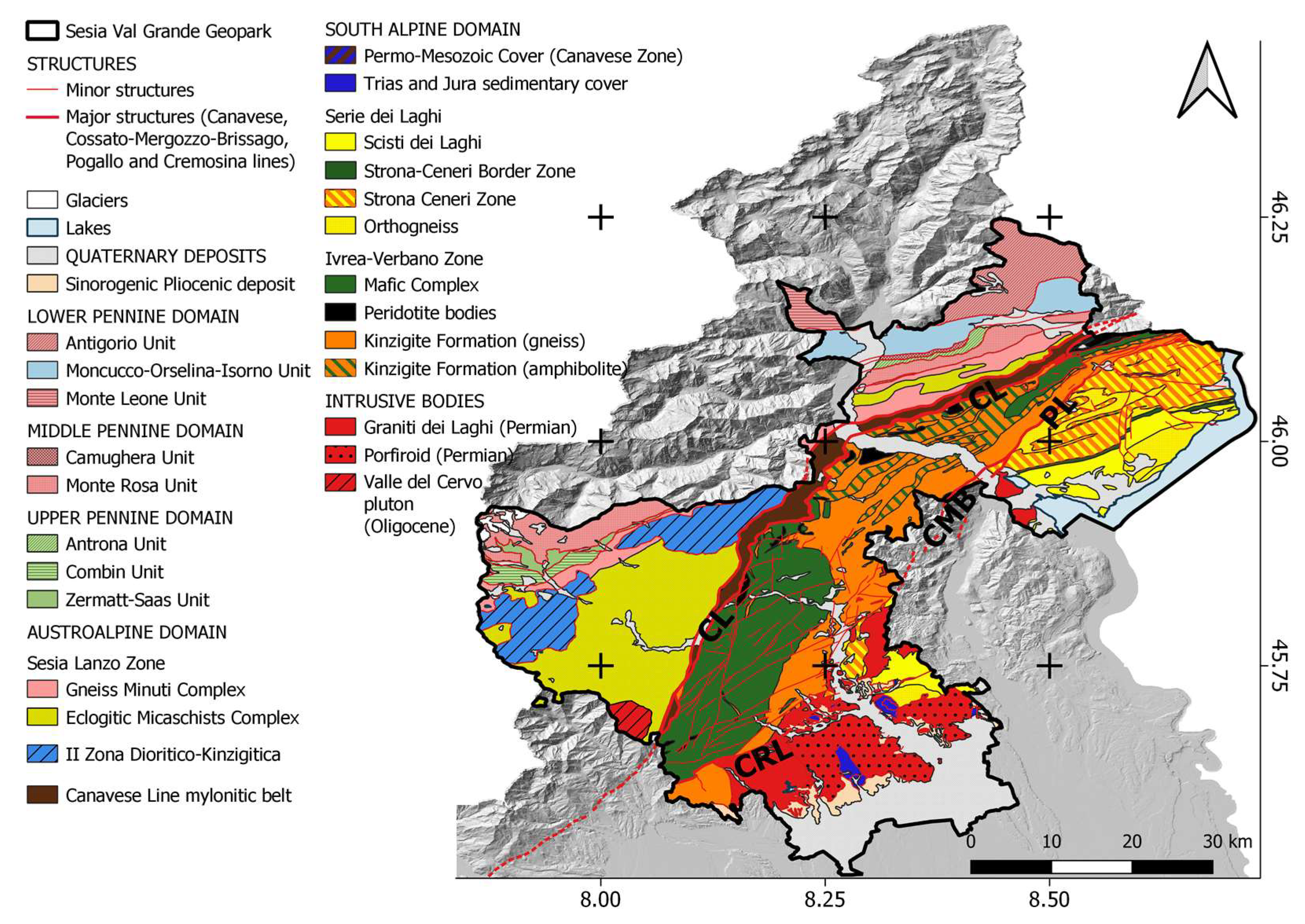
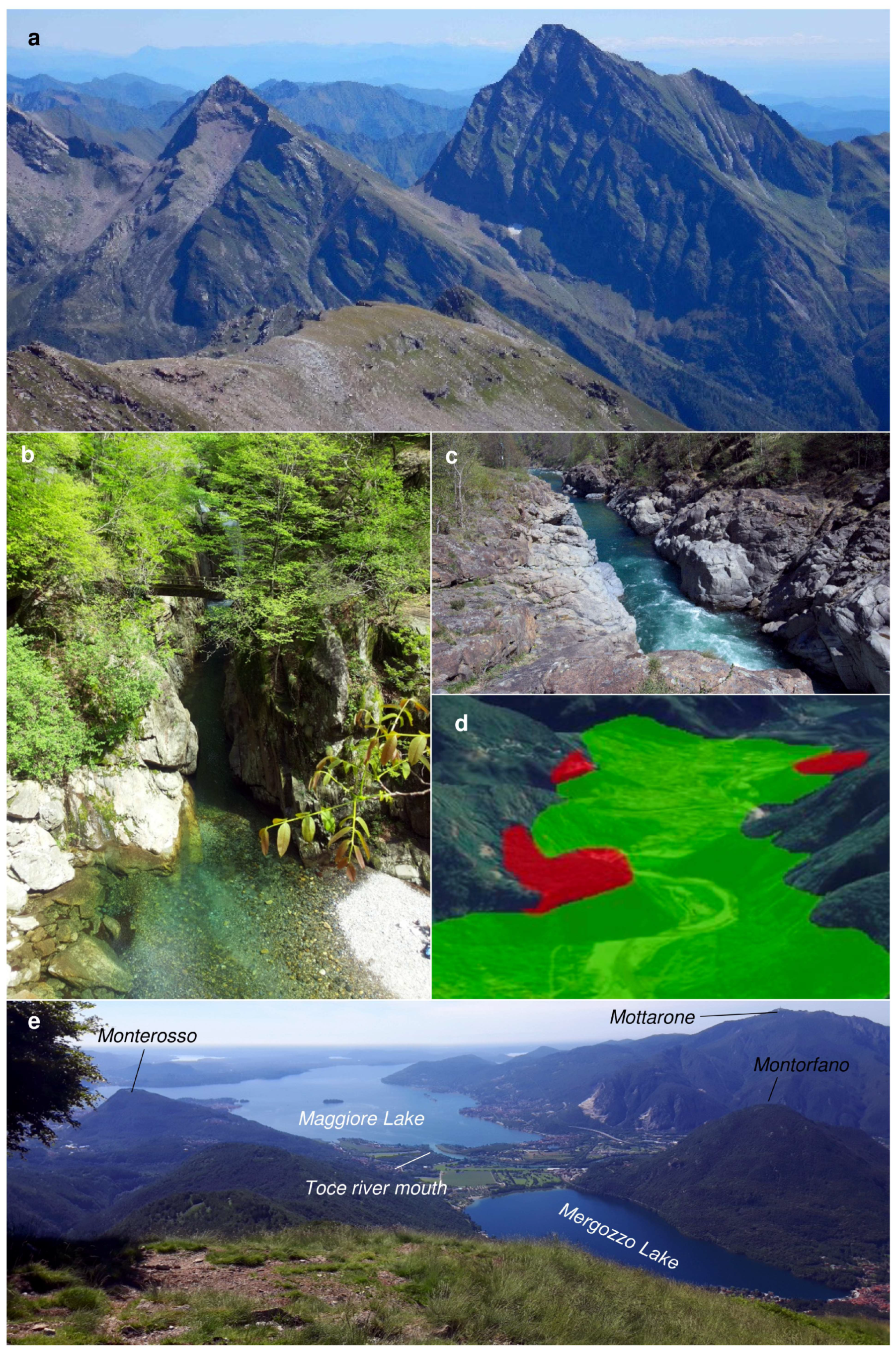
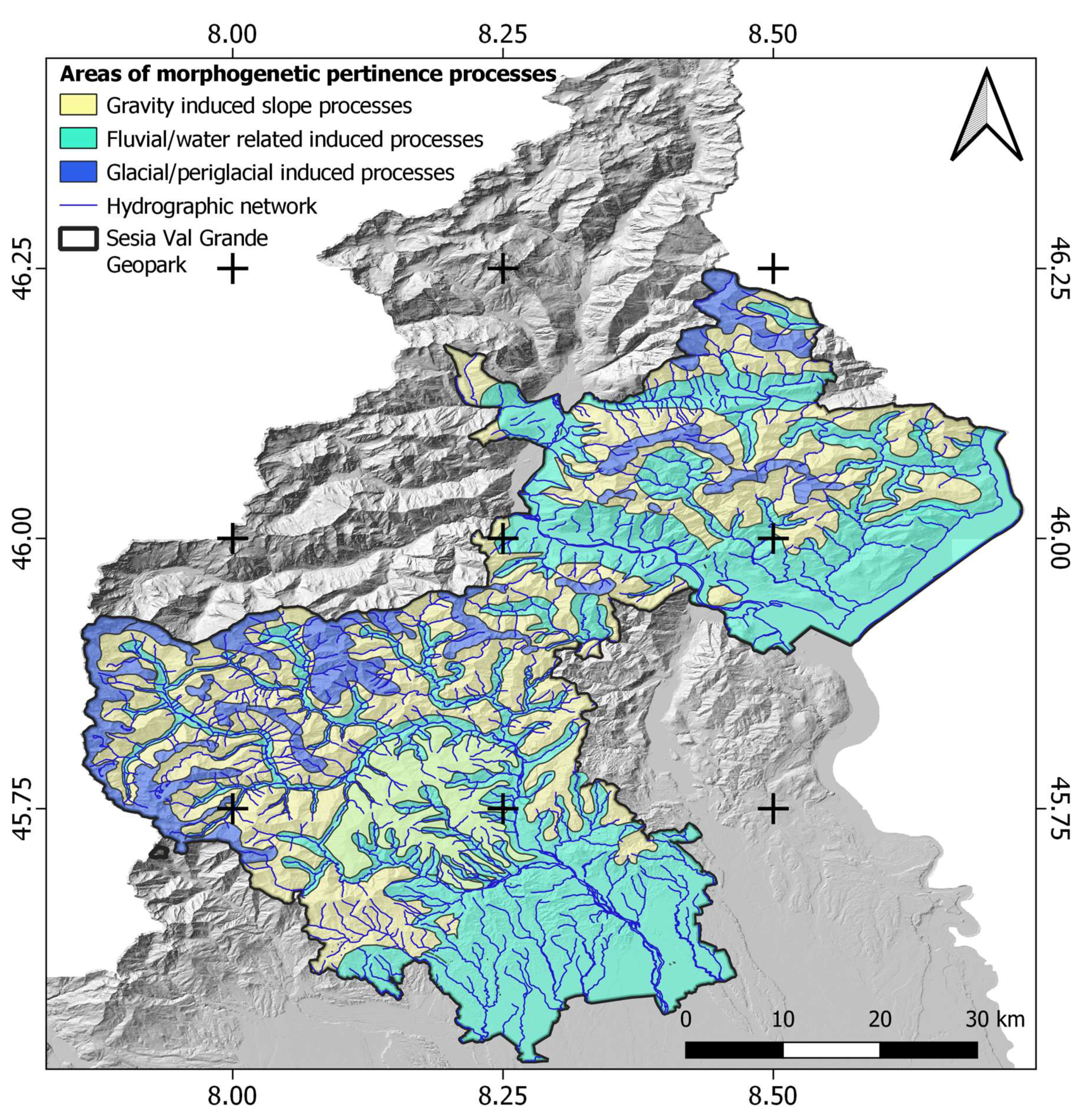
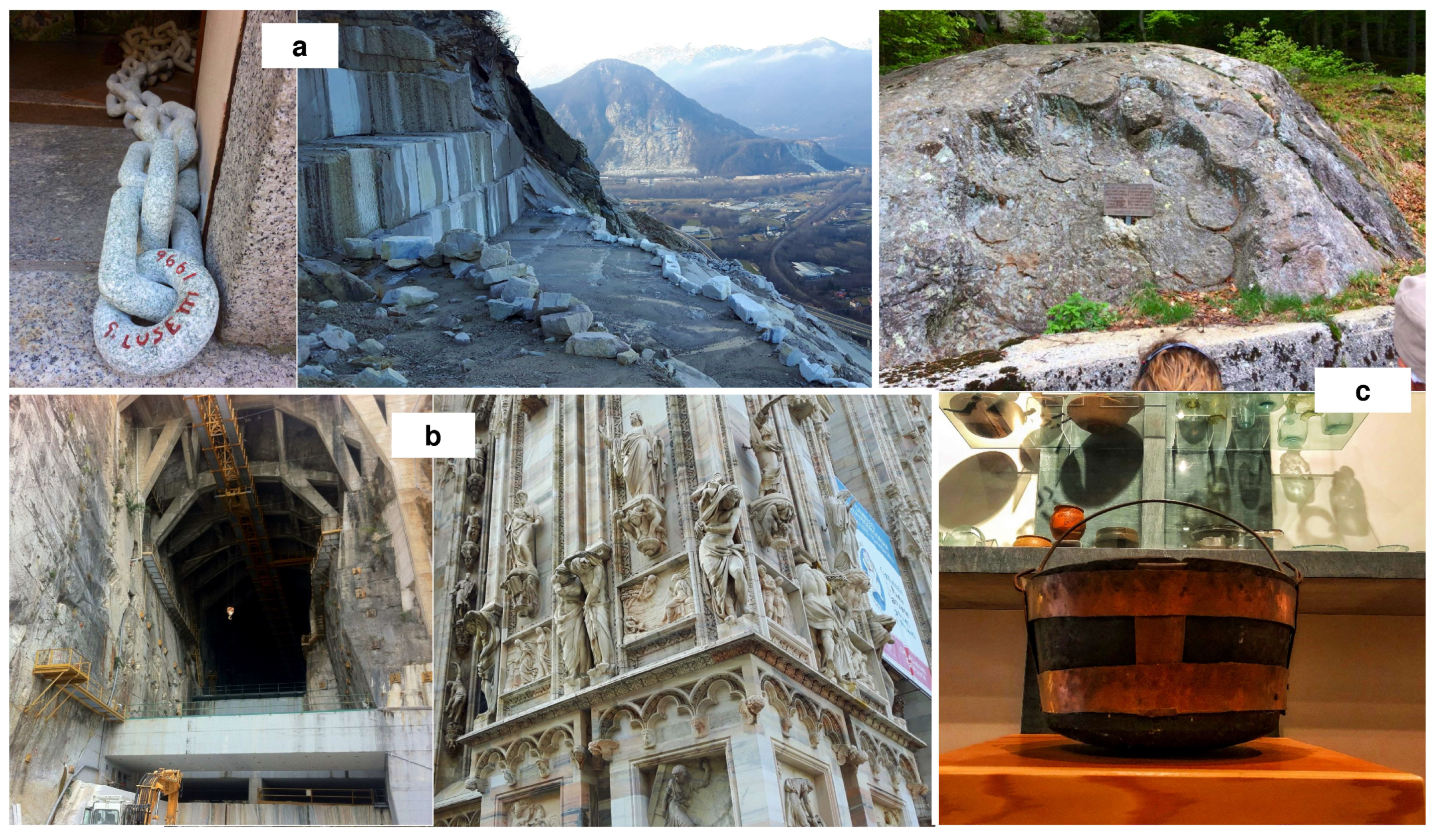
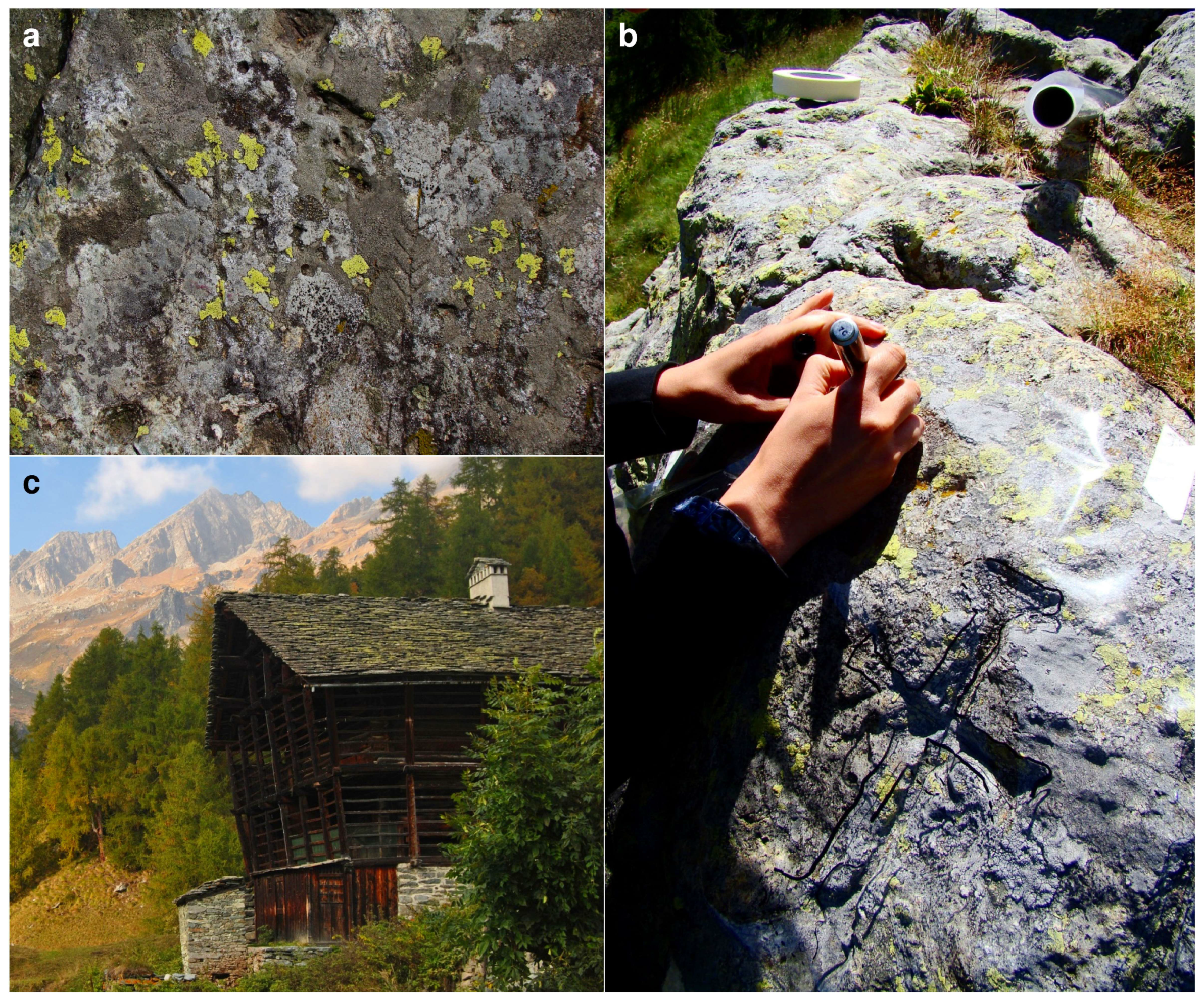
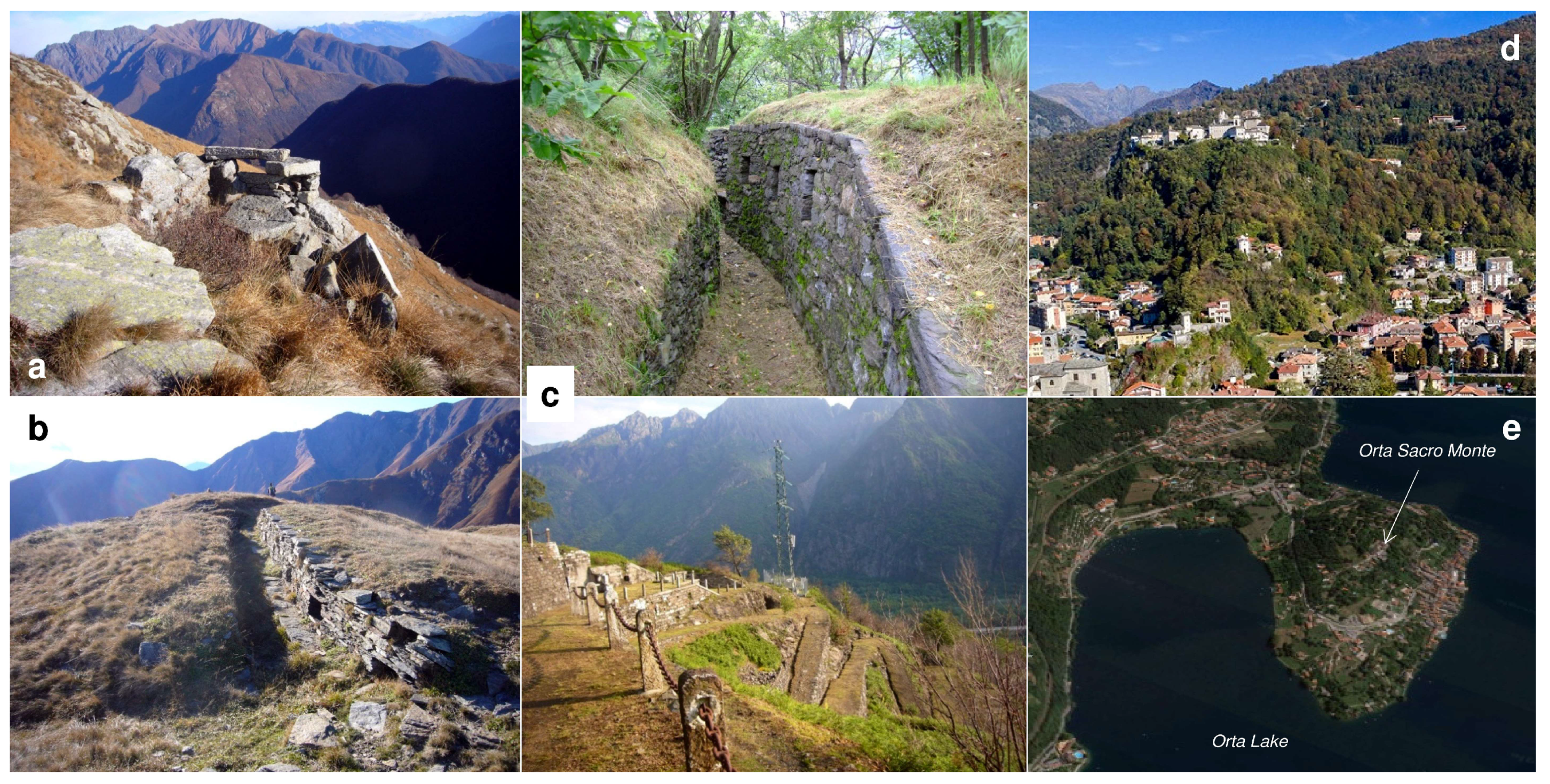

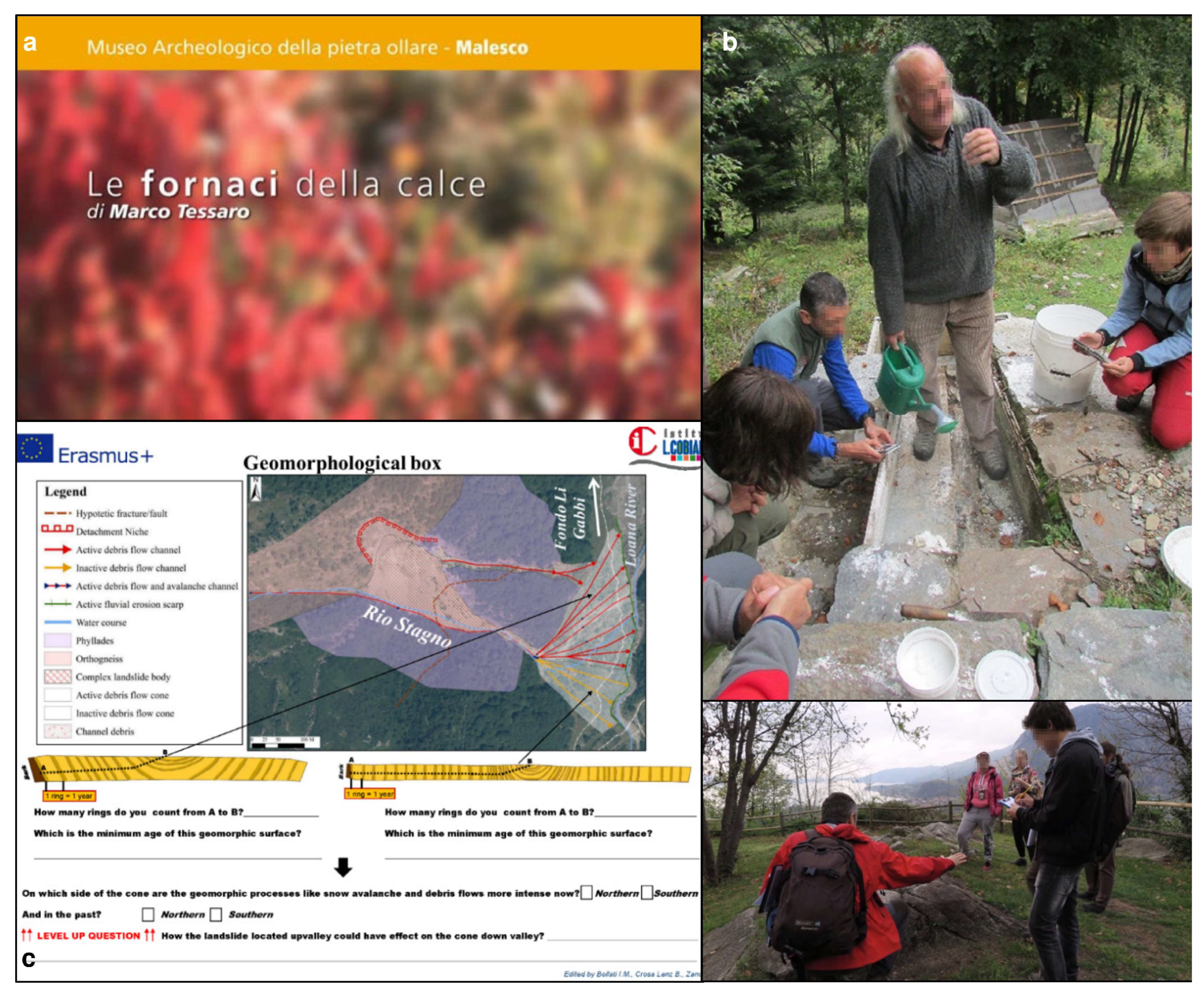
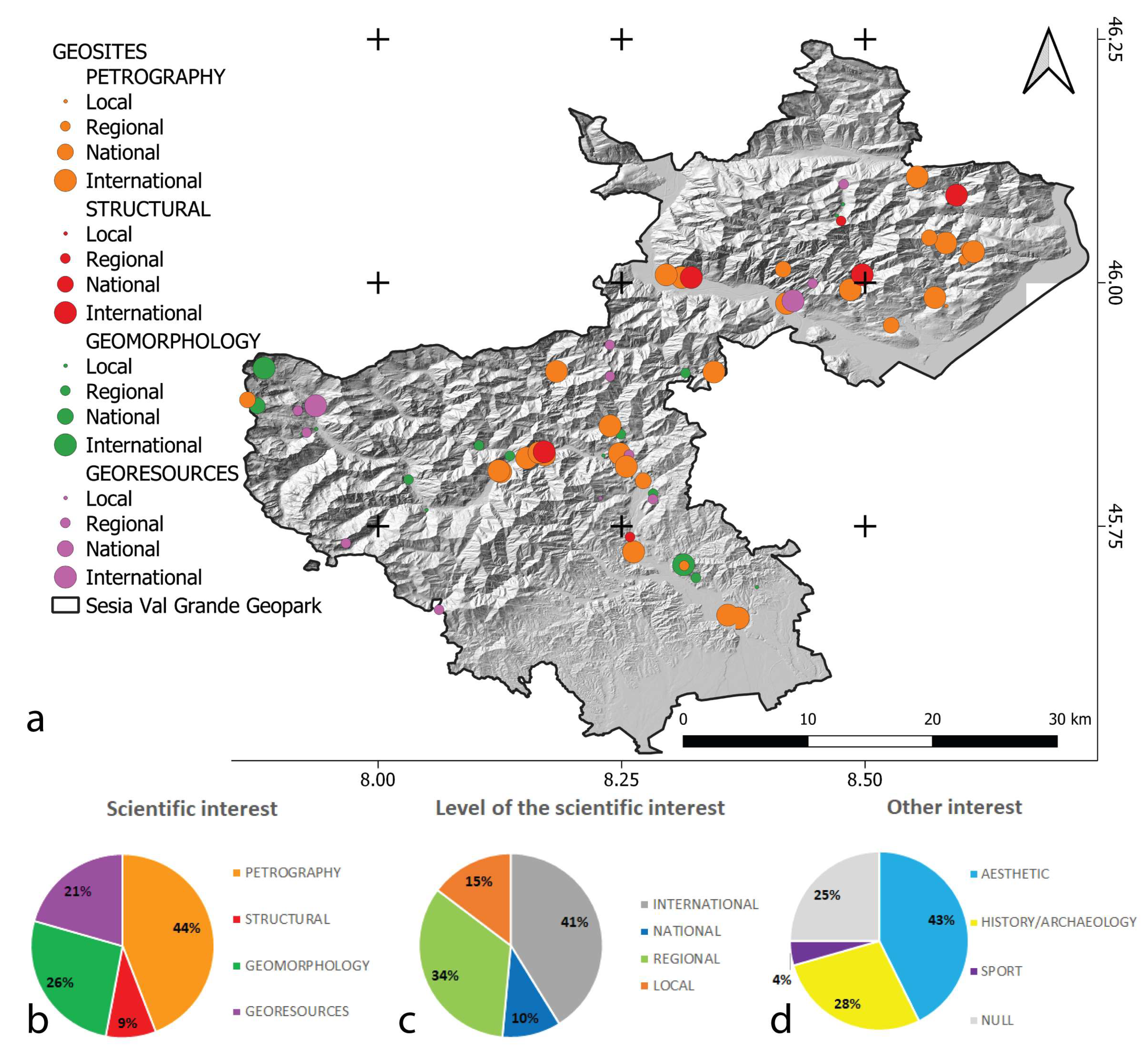
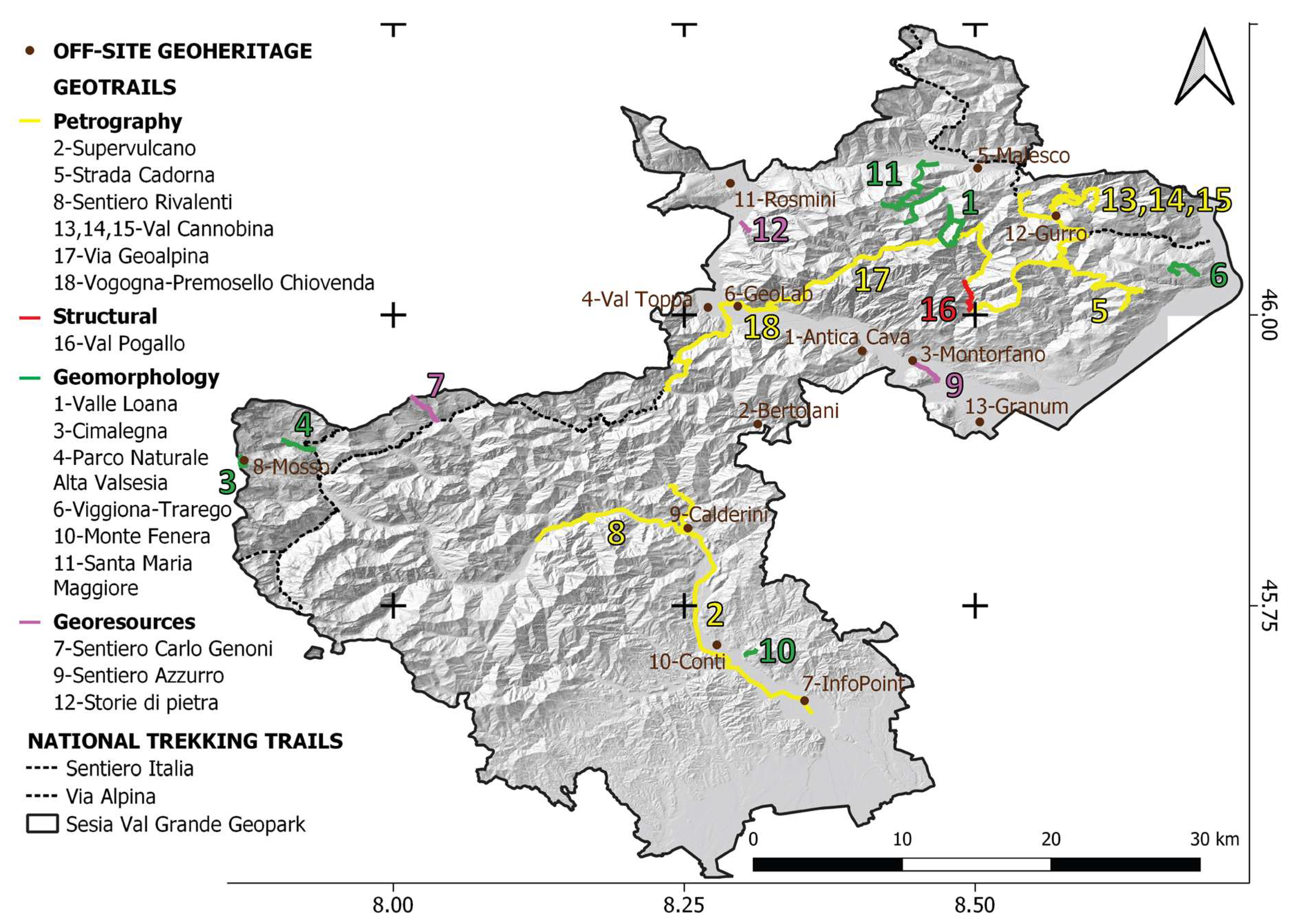
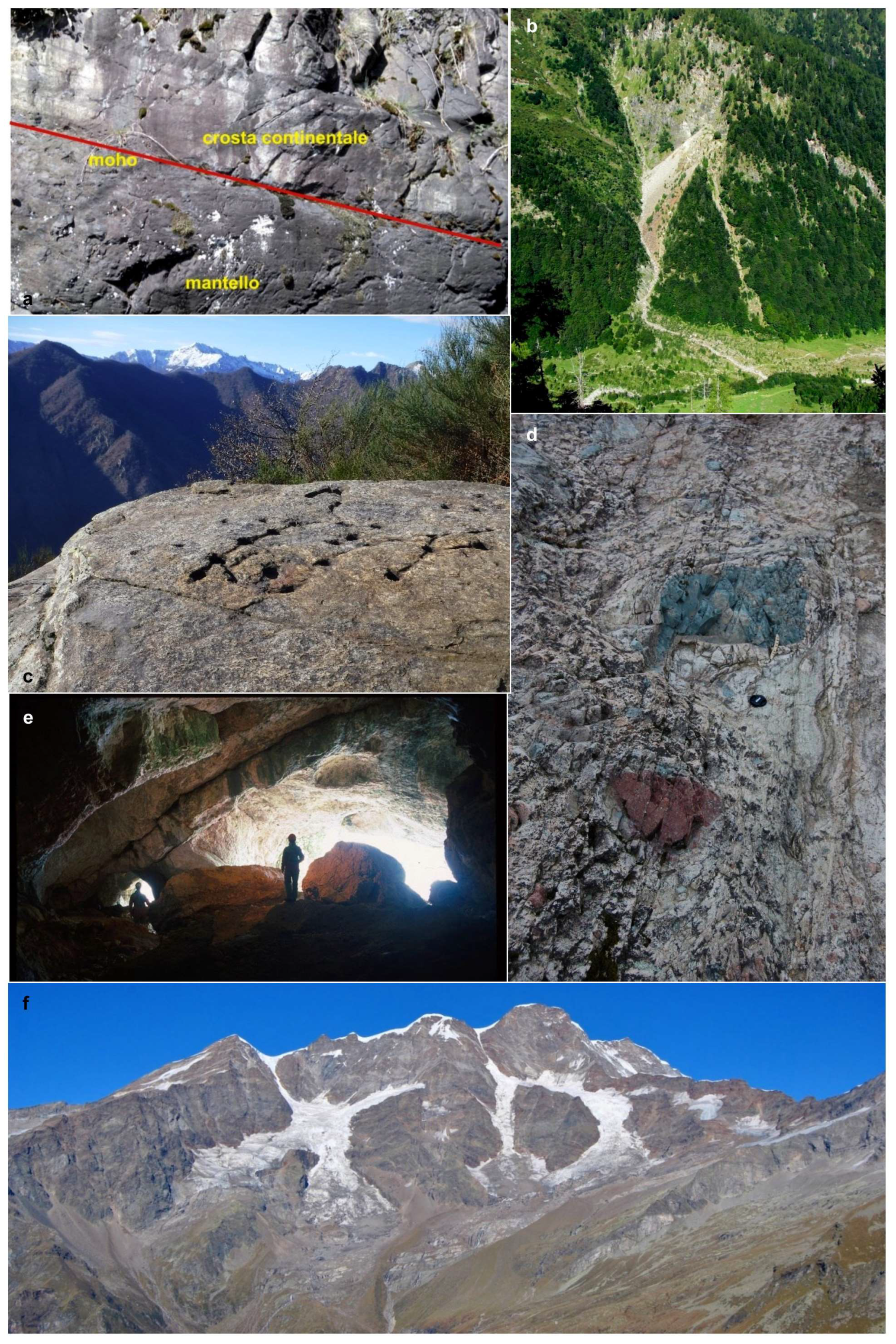
© 2020 by the authors. Licensee MDPI, Basel, Switzerland. This article is an open access article distributed under the terms and conditions of the Creative Commons Attribution (CC BY) license (http://creativecommons.org/licenses/by/4.0/).
Share and Cite
Perotti, L.; Bollati, I.M.; Viani, C.; Zanoletti, E.; Caironi, V.; Pelfini, M.; Giardino, M. Fieldtrips and Virtual Tours as Geotourism Resources: Examples from the Sesia Val Grande UNESCO Global Geopark (NW Italy). Resources 2020, 9, 63. https://doi.org/10.3390/resources9060063
Perotti L, Bollati IM, Viani C, Zanoletti E, Caironi V, Pelfini M, Giardino M. Fieldtrips and Virtual Tours as Geotourism Resources: Examples from the Sesia Val Grande UNESCO Global Geopark (NW Italy). Resources. 2020; 9(6):63. https://doi.org/10.3390/resources9060063
Chicago/Turabian StylePerotti, Luigi, Irene Maria Bollati, Cristina Viani, Enrico Zanoletti, Valeria Caironi, Manuela Pelfini, and Marco Giardino. 2020. "Fieldtrips and Virtual Tours as Geotourism Resources: Examples from the Sesia Val Grande UNESCO Global Geopark (NW Italy)" Resources 9, no. 6: 63. https://doi.org/10.3390/resources9060063
APA StylePerotti, L., Bollati, I. M., Viani, C., Zanoletti, E., Caironi, V., Pelfini, M., & Giardino, M. (2020). Fieldtrips and Virtual Tours as Geotourism Resources: Examples from the Sesia Val Grande UNESCO Global Geopark (NW Italy). Resources, 9(6), 63. https://doi.org/10.3390/resources9060063





